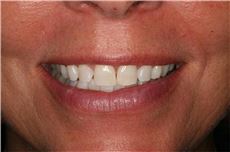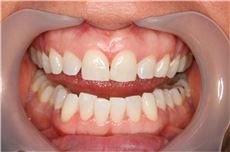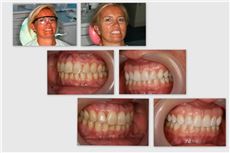Tooth Whitening
Why Do Teeth Become Yellowish Or Brownish-Colored ?

Tooth color varies from individual to individual depending on the density of protein layer inside the teeth. The most usual case of acquired discolorations is the darkening of the teeth with advancing age. Consumption of stain-causing beverages (coffees, teas, colas etc.), tobacco use; traumas to the teeth, old dentures, laminate veneers and fillings could also lead to discoloration. Use of antibiotics (such as tetracycline) during tooth development or extensive fluor intake may cause tooth discoloration as well.
Who Are Candidates For Tooth Whitening And When Is It Indicated ?
If your teeth have a dark hue or take on a yellowish, greyish or brownish hue or are stained on the surface, then you might get your teeth whitened after an examination by your dentist.The whitening procedure is carried out easily in a healthy mouth. It is a safe solution for a whiter and more natural smile.
Is Tooth Whitening Safe ?
Yes it is ! According to numerous studies, the whitening procedure is extremely effective and safe if performed under medical supervision.The whitening procedure can make teeth up to six shades lighter. No harmful effects on teeth or gums are seen. Occasionally, teeth could become a bit more sensitive to cold or hot. However, this will subside completely when the treatment is carried out intermittently or terminated.


How Long Does The Procedure Take ?

In most cases, whitening effect is seen immediately. However, total treatment should be continued for at least 10 to 14 days at home or 4 to 5 appointments in dentist’s office.
Can Teeth Return To Their Previous Conditions After Whitening ?
The teeth will not take on their previous colors and always look whiter than before. However, a “reinforcement” treatment could be necessary in 1 to 2 years’ time, depending on patients’ habits and oral hygiene status.
What Is Tooth Whitening And How İs İt Carried Out ?
Tooth whitening is a procedure to lighten teeth and remove stains and discolorations occurring within the structure
(enamel-dentine layers) of the teeth. At present there are two different methods of tooth whitening:
The first method, which is self-practicable, involves the following steps: * Your dentist will take an impression of your teeth and have a thin rubber mould prepared, that you will put around your teeth. * The patient puts the whitening product into the special mould and applies it onto the teeth to be whitened for at least 6 to 8 hours daily (preferentially during sleep). * Termination of the treatment in 1 to 2 weeks on the average.
The second method is carried out in a dentist’s office and involves the following: * The whitening substance is applied to the teeth by an experienced dentist * A laser or UV light is shone onto the relevant teeth for a certain time to enhance the action of the agent. * The whitening effect is seen immediately at the end of the procedure. Although at-home procedures are more effective, the choice will depend on factors such as the extent of discoloration, desired time-span of the treatment and dentist’s opinion.


bleaching

internal bleaching